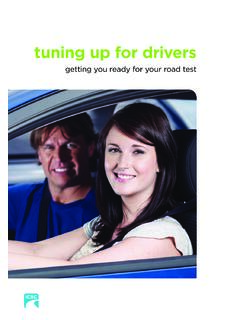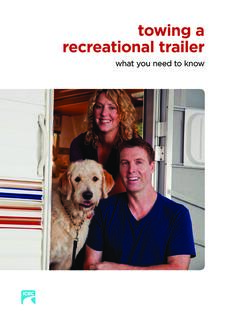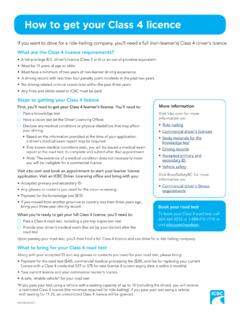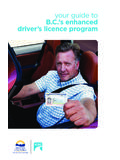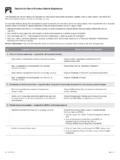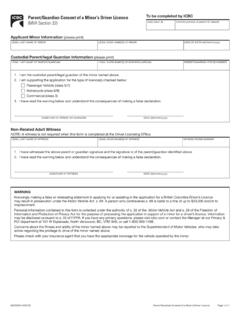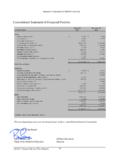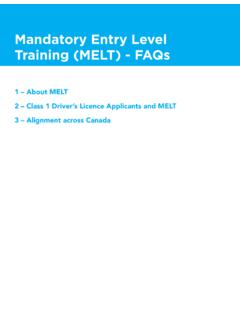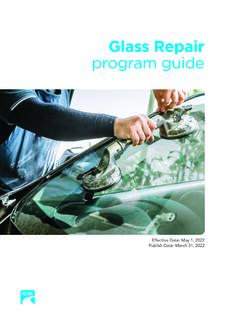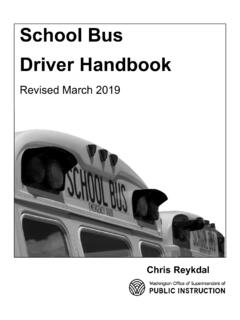Transcription of Learn to Drive Smart Manual - chapter 5 - ICBC
1 59see-think-do5In the previous four chapters, you began developing your Smart driving skills by learning the basics of driving: being a thinking driver maintaining a safe vehicle understanding signs, signals and road markings knowing the rules of the road. This chapter will bring all of these concepts together and describe how to use them as part of see-think-do a driving strategy that helps you to be a safe and competent driver. see scan for hazards. Pay attention to other road users and the areas where hazards could occur. think decide which hazards are the most dangerous. Think quickly about possible solutions.
2 Decide on the safest solution. do do manoeuvres to keep yourself and others safe. see-think-doWhenever you Drive , your eyes should be scanning the area around you to gather information. Good observation means knowing how to look and where to look. The next step is hazard perception knowing what to look for. ObservationGood observation involves looking ahead, beside and behind. You in the driver s seatYou re driving along a city street, scanning well ahead. You check your mirrors the car behind is keeping well back. There is an intersection ahead. You carefully scan the intersection to see if it s clear before you proceed.
3 See observation hazard perception Think assess the risk choose a solution Do speed control steering space margins communication Using see think do in this chapter60developing your Smart driving skillsObserving ahead Research shows that new drivers spend so much time looking at the road just in front of their vehicle that they often miss hazards further ahead. Make sure you know what s coming up by scanning at least 12 seconds ahead. This means look one to two blocks ahead in city driving and half a kilometre ahead on the highway.
4 This will give you time to prepare for a potential hazard instead of being taken by surprise. As you look ahead, scan to the left and right so you can see what s happening along the sides of the road. If you see cars parked by the side of the road, be careful. A child may be walking out from between them, or a door might be about to swing open. Strategies: the observation cycleAlways keep your eyes moving while you re driving: look well ahead scan from one side of the road to the other, checking for potential hazards glance in your rear and side view mirrors to keep track of what is happening behind you.
5 Then start all over again. You should complete the whole cycle every five to eight t overdrive your ability to see. You should always be able to stop within the distance you can see. warning!By looking ahead, you can avoid sudden stops, which increase your fuel tipIt s easiest to see things that are directly in front of you, in your central vision. But it s important to also pay attention to things outside your central vision. Peripheral vision allows you to see more than what is directly in front of 5 see-think-do61 Each vehicle has smaller blind spots at the front and at the back, as well as the two large blind spots on the sides.
6 Their size depends on the shape and size of your vehicle. Try sitting in your vehicle and finding the areas you can t see even when you use your mirrors. Observing behind Your side and rear view mirrors let you know what is happening behind you. Adjust them to get the best possible view. Look in each mirror about every five to eight seconds and pay attention to what you see. Rear-view mirrors look in the rear view mirror before you slow down or stop. Will the cars behind you have space to stop? If not, you may need to take action. Side-view mirrors use your side view mirrors whenever you are planning to change your road position or direction.
7 When you re pulling away from the right side of the road, you need to check your left mirror to make sure there are no cars coming from behind. If you re making a lane change to the right, check your right mirror to make sure there s enough space to move into. Blind spots even when your mirrors are properly adjusted, there are large areas that you can t see in your mirrors. These are called blind spots. The most dangerous blind spots are to the side. There are also blind spots below your field of vision to the front, rear and both sides of your vehicle. Blind spotBlind spotBlindspotBlindspotBlind spot detectors, cameras Some vehicles are equipped with blind spot detectors and/or back up cameras.
8 While these can help you to detect hazards in blind spots or behind the vehicle, they do not replace the need to turn your head to do a shoulder check or look checks whenever you plan to change your direction or road position, do a shoulder check to make sure the blind spot on that side is clear. When you re going to turn right, for example, quickly check to the right just to make sure no one is in that space. And don t forget to do a mirror check and shoulder check before you open your door to get out of your vehicle. A cyclist or other vehicle could be coming up beside your Smart driving skillsStrategies: making your moveCheck your mirrors and do a shoulder check whenever you plan to: pull out from the side of the road pull over to the side of the road change lanes turn left or turn right.
9 Before you start to back up, give a quick warning tap on your horn if visibility is tipAlmost 60 per cent of all crashes in happen at : ICBC reported five year average from 2009 to factBacking up before you back up, make sure you do a 360 degree vision check. Look all around the vehicle using shoulder checks and mirror checks, and then turn your body to look out the rear window while backing up. Be especially careful when you re backing out of a driveway. It s easy to miss seeing children, pets, pedestrians, cyclists and people in wheelchairs. If you ve been stopped for some time, walk around the back of your vehicle to check that your path is clear.
10 Better yet, try to back into driveways and parking spots so you can Drive out facing forward. Observing at intersections Look well ahead as you approach an intersection. Check for signs, signals and other clues about whether you will need to stop. As you re approaching an intersection, scan the road you are crossing look left, centre, right, then glance left again. If an oncoming vehicle is turning left, take extra care the driver may not see you. And check crosswalks you intend to cross to make sure they are a shoulder check to be certain your blind spot is clear before you move your vehicle into another lane or in a different direction.
